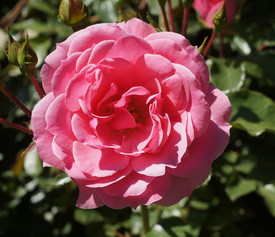 If June is the month of wine and roses, then July is the month of their maintenance. June’s glorious floral exuberance has just finished and the dead blossoms should be pruned off to enhance the next flush of flowers.
If June is the month of wine and roses, then July is the month of their maintenance. June’s glorious floral exuberance has just finished and the dead blossoms should be pruned off to enhance the next flush of flowers.
But first some history. Roses have been grown around the Mediterranean, in Persia and China since 500 BC. Cleopatra decorated her extravaganzas with hundreds of them. And wine too. Because roses are so beautiful, countless varieties have been developed. The older ones bloom only once a year, and their glory lasts but a few weeks. Happily, newer varieties repeat bloom.
There was even a War of the Roses in 15th century England, where the whites fought the reds for 37 years, to see who would rule. A marriage finally united the 2 sides and ended hostilities. Ever since, the official English Emblem has been a red rose with a white center.
A personal confession here. In our first house I inherited fences covered with enormous, old red roses with huge thorns. They required constant, painful pruning. When we moved, I vowed never again! I planted only one fragile beautiful climber.
 However, missing their beauty, I’ve since added a few. Only three white ones survived, but I get four sequences of flowering and blossoms to cut whenever I want. Roses are delicate and high maintenance but are a labor of love. In truth, I enjoy pruning them. It’s a relaxing challenge.
However, missing their beauty, I’ve since added a few. Only three white ones survived, but I get four sequences of flowering and blossoms to cut whenever I want. Roses are delicate and high maintenance but are a labor of love. In truth, I enjoy pruning them. It’s a relaxing challenge.
Some tips: First about pruning off those dead blossoms (called deadheading). New flowering buds are formed in the space where a five leaf twig grows from a stem. Prune about an inch above the twig, at an angle, with sharp shears. Cut off the dead flowers, their three leaf twig and its stem.
I have been experimenting with my rose pruning for years, and each time I learn something new because each rose variety has to be pruned differently. There are floribundas, tea roses, antique roses, climbers, miniatures, ground covers and more.
The newest variety, a bush rose called Knock Out, is a continual bloomer, disease resistant and very easy to grow. It’s so popular that many other varieties are not selling well. This may cause many more beautiful varieties to become hard to find, like the old historic roses are now.
 My best rose info comes from a tiny, old booklet. How to read the age of a stem: New shoots are supple, reddish or greenish, and have reddish thorns.
My best rose info comes from a tiny, old booklet. How to read the age of a stem: New shoots are supple, reddish or greenish, and have reddish thorns.
One year old stems are green with green thorns, and are the workhorses of the bush. Old stems are brownish and cracking, with thorns that are not as sharp. (But they still hurt!)
Rose bushes need a few vigorous new shoots every year or so to replace those that get too old. (A bit of magnesium encourages new shoots.) Apply a good balanced rose fertilizer for bigger, better growth, but not after July 30. (New soft growth winter kills.) They do not like acid soil. (Dig in a little lime.) Spray selectively for serious insects or diseases or live with some imperfection. Some varieties are genetically more resistant.
There is a huge, fascinating rose garden at Olmsted’s Elizabeth Park in Hartford, Connecticut. The best place for varieties and detailed growing specifics is the websites of large rose growers. (Jackson Perkins, Burpee) Just read. Then buy
local. Actually, the mother of all the owners of (Massachusetts) Mahoney Garden Shops was a rose expert.
Roses have a certain beguiling beauty. Cleopatra knew. So does anyone who grows them. Though fragile and fleeting, they warm the soul.
Ruth S. Foster is a landscape consultant and arborist. More gardening
information can be found on her website: www.mothersgarden.net.
Credit: www.mothersgarden.net




























